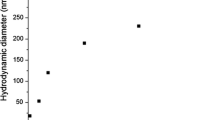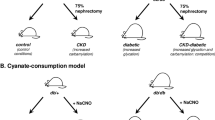Abstract
Advanced glycation end products (AGEs) as a result of Maillard reaction are currently at the heart of the pathogenesis of several diseases and hence are the objective of numerous investigations. Glycation of proteins has been an implication in long-term complications. Collagen is the most abundant protein in the human body. The purpose of this study was to monitor and characterize the oligomeric aggregates and AGEs of human collagen on addition of glyoxal using ultraviolet, fluorescence, circular dichroism (CD) spectroscopy, docking studies, ITC, and microscopy. Collagen was incubated for varying time periods up to 21 days with three different concentrations (5, 20, and 40 mM) of glyoxal. Collagen exists as molten globule at day 6, evident from native-like secondary structure, altered tryptophan, and high ANS fluorescence due to surface-exposed hydrophobic residues. Glycated collagen as AGEs and aggregates was observed at day 18 and 21, respectively. Formation of AGE and aggregates were confirmed by UV and fluorescence spectroscopy. The obtained AGEs were characterized with respect to the extent of side chain modifications (lysine and arginine) forming the Schiff base, the carboxymethyl lysine, and carbonyl content. Non-tryptophan fluorescence for AGEs was also monitored as the emission peak at 400 and 440 nm, respectively. SEM and TEM confirmed the oligomeric nature of aggregates. Glyoxal at 40 mM shows maximum alterations in protein structure followed by 20 and 5 mM concentration. In the present paper, we propose that a high concentration of glyoxal for a prolonged time results in the formation of harmful aggregates and AGEs.












Similar content being viewed by others
References
Ahmed N, Argirov OK, Minhas HS, Cordeiro CA, Thornalley P (2002) Assay of advanced glycation end-products (AGEs): surveying AGEs by chromatographic assay with derivatization by 6-aminoquinolyl-N-hydroxysuccinimidyl-carbamate and application to Nepsilon-carboxymethyl-lysine- and Nepsilon-(1-carboxyethyl) lysine-modified albumin. Biochem J 364:1–14
Amani S, Naeem A (2014) Deciphering aggregates, prefibrillar oligomers and protofibrils of cytochrome c. Amino Acids 46:1839–1851
Ashraf MJ, Shahab U, Tabrez S, Lee EJ, Choi I (2015) Quercetin as a finer substitute to aminoguanidine in the inhibition of glycation products. IJBM 77:188–192
Banerjee T, Kishore N (2005) 2,2,2-trifluoroethanol-induced molten globule state of concanavalin a and energetics of 8-anilinonaphthalene sulfonate binding: calorimetric and spectroscopic investigation. J Phys Chem B 109:22655–22662
Baynes JW (1991) Role of oxidative stress in the development of complications in diabetes. Diabetes 40:405–412
Chiti F, Taddei N, Baroni F, Capanni C, Stefani M, Ramponi G, Dobson CM (2002) Kinetic partitioning of protein folding and aggregation. Nat Struct Biol 9:137–143
Dobler D, Ahmed N, Song L, Eboigbodin KE, Thornallaey PJ (2006) Increased dicarbonyl metabolism in endothelial cells in hyperglycemia induces anoikis and impairs angiogenesis by RGD and GFOGER motif modification. Diabetes 55:1961–1969
Eisert R, Felau L, Brown LR (2006) Methods for enhancing the accuracy and reproducibility of Congo red and thioflavin T assays. Anal Biochem 353:144–146
Fazili N, Naeem A (2015) Anti-fibrillation potency of caffeic acid against an antidepressant induced fibrillogenesis of human alpha-synuclein: implications for Parkinson’s disease. Biochimie 108:178–185
Greenfield NJ (2007) Using circular dichroism spectra to estimate protein secondary structure. Nat Protoc 1:2876–2890
Haynes R, Osuga DT, Feeney RE (1967) Modification of amino groups in inhibitors of proteolytic enzymes. Biochemistry 6:541–547
Hodge JE (1955) The Amadori rearrangement. Adv Carbohydr Chem 10:169–205
Iram A, Naeem A (2012) Trifluoroethanol and acetonitrile induced formation of the molten globule states and aggregates of cellulose. Int J Biol Macromol 50:932–938
Iram A, Amani S, Furkan M, Naeem A (2013) Equilibrium studies of cellulase aggregates in presence of ascorbic and boric acid. Int J Biol Macromol 52:286–295
Khan TA, Amani S, Naeem A (2011) Glycation promotes the formation of genotoxic aggregates in glucose oxidase. Amino Acids 43:1311–1322
Khan MS, Dwivedi S, Priyadarshini M et al (2013) Ribosylation of bovine serum albumin induces ROS accumulation and cell death in cancer line (MCF-7). Eur Biophys J 42:811–818
Khan MS, Tabrez S, Rabbani N, Shah A (2015) Oxidative stress mediated cytotoxicity of glycated albumin: comparative analysis of glycation by glucose metabolites. J Fluoresc 25:1721–1726
Lowry OH, Rosebrough NJ, Farr AL, Randall RJ (1951) Protein measurement with the Folin phenol reagent. J Biol Chem 193:265–275
Naeem A, Amani S (2013) Deciphering structural intermediates and genotoxic fibrillar aggregates of albumins: a molecular mechanism underlying for degenerative diseases. PLoS One 8:e54061
Naeem A, Iram A, Bhatt SA (2015) Anesthetic 2,2,2-trifluoroethanol induces amyloidogenesis and cytotoxicity in human serum albumin. Int J Biol Macromol 79:726–735
Raabe HM, Molsen H, Mlinaric SM, Acil Y, Sinnecker GH, Notbohm H, Kruse K, Muller PK (1996) Biochemical alterations in collagen IV induced by in vitro glycation. Biochem J 319:699–704
Rabbani N, Thornalley PJ (2012) Glycation research in amino acids: a place to call home. Amino Acids 42:1087–1096
Rondeau P, Navarra G, Cacciabaudo F, Leone M, Bourdon E, Militello V (2010) Thermal aggregation of glycated bovine serum albumin. Biochim Biophys Acta 1804:789–798
Stryer L (1968) Fluorescence spectroscopy of proteins. Science 162:526–540
Trott O, Olson AJJ (2010) Auto Dock Vina: improving the speed and accuracy of docking with a new scoring function, efficient optimization, and multithreading. Comput Chem 31:455–461
Wei Y, Chen L, Chen J, Ge L, He RQ (2009) Rapid glycation with d-ribose induces globular amyloid-like aggregations of BSA with high cytotoxicity to SH-SY5Y cells. BMC Cell Biol 10:10 doi:10.1186/1471-2121-10-10
Acknowledgments
Facilities provided by Aligarh Muslim University are gratefully acknowledged. Financial support received from the CSIR [37(1631)/14/EMR-II] in the form of project is gratefully acknowledged.
Author information
Authors and Affiliations
Corresponding author
Ethics declarations
Conflict of interest
The authors declare that they have no competing financial interests.
Electronic supplementary material
Below is the link to the electronic supplementary material.


Rights and permissions
About this article
Cite this article
Shamsi, A., Amani, S., Alam, M.T. et al. Aggregation as a consequence of glycation: insight into the pathogenesis of arthritis. Eur Biophys J 45, 523–534 (2016). https://doi.org/10.1007/s00249-016-1119-0
Received:
Revised:
Accepted:
Published:
Issue Date:
DOI: https://doi.org/10.1007/s00249-016-1119-0




